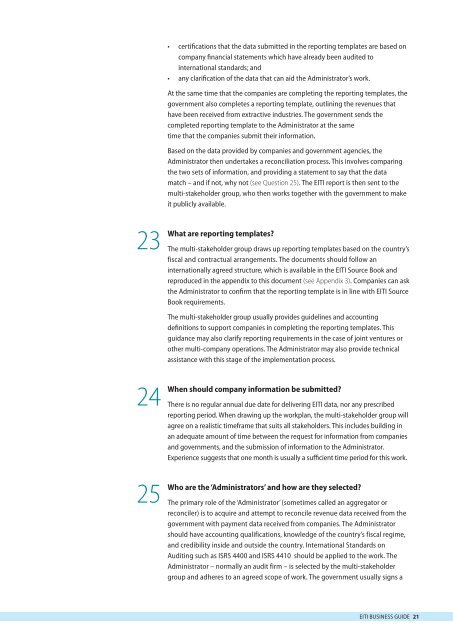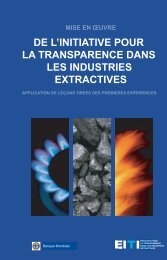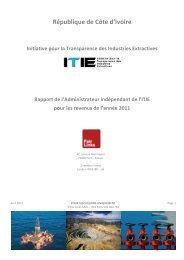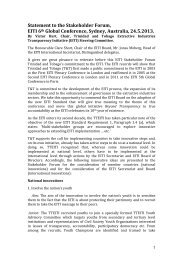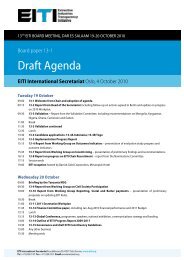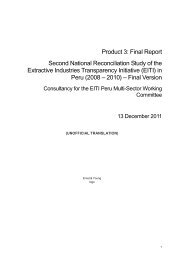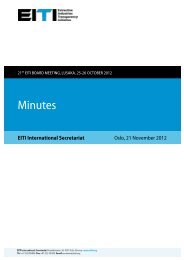EITI Business Guide
EITI Business Guide
EITI Business Guide
You also want an ePaper? Increase the reach of your titles
YUMPU automatically turns print PDFs into web optimized ePapers that Google loves.
23<br />
24<br />
25<br />
• certifications that the data submitted in the reporting templates are based on<br />
company financial statements which have already been audited to<br />
international standards; and<br />
• any clarification of the data that can aid the administrator’s work.<br />
at the same time that the companies are completing the reporting templates, the<br />
government also completes a reporting template, outlining the revenues that<br />
have been received from extractive industries. The government sends the<br />
completed reporting template to the administrator at the same<br />
time that the companies submit their information.<br />
Based on the data provided by companies and government agencies, the<br />
administrator then undertakes a reconciliation process. This involves comparing<br />
the two sets of information, and providing a statement to say that the data<br />
match – and if not, why not (see Question 25). The <strong>EITI</strong> report is then sent to the<br />
multi-stakeholder group, who then works together with the government to make<br />
it publicly available.<br />
What are reporting templates?<br />
The multi-stakeholder group draws up reporting templates based on the country’s<br />
fiscal and contractual arrangements. The documents should follow an<br />
internationally agreed structure, which is available in the <strong>EITI</strong> source Book and<br />
reproduced in the appendix to this document (see Appendix 3). companies can ask<br />
the administrator to confirm that the reporting template is in line with <strong>EITI</strong> source<br />
Book requirements.<br />
The multi-stakeholder group usually provides guidelines and accounting<br />
definitions to support companies in completing the reporting templates. This<br />
guidance may also clarify reporting requirements in the case of joint ventures or<br />
other multi-company operations. The administrator may also provide technical<br />
assistance with this stage of the implementation process.<br />
When should company information be submitted?<br />
There is no regular annual due date for delivering <strong>EITI</strong> data, nor any prescribed<br />
reporting period. When drawing up the workplan, the multi-stakeholder group will<br />
agree on a realistic timeframe that suits all stakeholders. This includes building in<br />
an adequate amount of time between the request for information from companies<br />
and governments, and the submission of information to the administrator.<br />
Experience suggests that one month is usually a sufficient time period for this work.<br />
Who are the ‘Administrators’ and how are they selected?<br />
The primary role of the ‘administrator’ (sometimes called an aggregator or<br />
reconciler) is to acquire and attempt to reconcile revenue data received from the<br />
government with payment data received from companies. The administrator<br />
should have accounting qualifications, knowledge of the country’s fiscal regime,<br />
and credibility inside and outside the country. International standards on<br />
auditing such as Isrs 4400 and Isrs 4410 should be applied to the work. The<br />
administrator – normally an audit firm – is selected by the multi-stakeholder<br />
group and adheres to an agreed scope of work. The government usually signs a<br />
<strong>EITI</strong> BusInEss GuIdE 21


